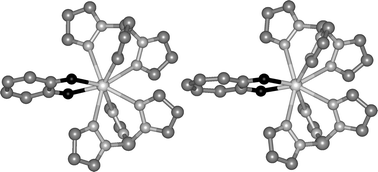We use the strategy of diamagnetic substitution for obtaining information on the crystal field effects in paramagnetic rare earth ions using the homologous series of compounds with the diamagnetic tropolonato ligand, Ln(Trp)(HBPz3)2, 1, and the paramagnetic semiquinone ligand, Ln(DTBSQ)(HBPz3)2, 2
(DTBSQ = 3,5-di-tert-butylsemiquinonato, Trp = tropolonate, HBPz3
= hydrotrispyrazolylborate) for Ln = Sm(III), Eu(III), Gd(III), Tb(III), Dy(III), Ho(III), Er(III) or Yb(III). The X-ray crystal structure of a new form of tropolonate derivative is presented, which shows, as expected, a marked similarity with the structure of the semiquinonate derivative. The Ln(Trp)(HBPz3)2 derivatives were then used as a reference for the qualitative determination of crystal field effects in the exchange coupled semiquinone derivatives. Through magnetisation and susceptibility measurements this empirical diamagnetic substitution method evidenced for Er(III), Tb(III), Dy(III) and Yb(III) derivatives a dominating antiferromagnetic coupling. The increased antiferromagnetic contribution compared to other radical–rare earth metal complexes formed by nitronyl nitroxide ligands may be related to the increased donor strength of the semiquinone ligand.


 Please wait while we load your content...
Please wait while we load your content...